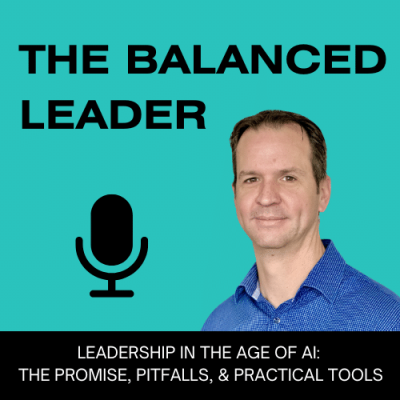Every day feels like another AI breakthrough announcement, and as leaders, we’re caught between excitement and terror about what this means for our work. I’ve been experimenting with AI tools for years, and I’m convinced that leaders who don’t start dabbling now risk getting left behind. But here’s the thing: AI isn’t about replacing your leadership, it’s about amplifying it without losing what makes you uniquely human.
In this episode, I’m sharing the promise and pitfalls of AI for leaders like you. I’ll walk you through three categories where AI can genuinely help: time-saving assistance, decision support, and coaching insights. But I’ll also warn you about the real risks: over automation, outsourcing judgment, and digital exhaustion. Plus, I’m giving you three specific AI tools to try this week, along with practical ways to use them without undermining your leadership presence.
Chapters
00: 07 – Welcome to The Balanced Leader Podcast
00:39 – On Being Equally Excited and Terrified of AI’s Potential
01:36 – Meet Chris: The Overstretched Leader
02:36 – AI: Your Digital Swiss Army Knife and Where it Can Help
04:25 – The Pitfalls of AI
06:11 – Three AI Tools to Try This Week
08:14 – Final Thoughts

Welcome to the Balance Leader Podcast, where we tackle the ultimate challenge for leaders, achieving peak performance without sacrificing your well-being. If you’re ready to lead with clarity, energy, and impact without burning out, then you’re in the right place. I’m Rob Hills, your leadership and well-being coach. And in each episode, I’ll give you the insights, tools, and strategies that will enable you to thrive. So without further ado, let’s dive into today’s episode.
I want to start today’s episode with a quote:
“The future is already here. It’s just not evenly distributed”.
That quote’s by William Gibson.
I don’t know about you, but it feels like every other day there is an announcement about how AI is getting smarter and it’s coming for our jobs. I’m equal parts terrified and excited by a promise of what it can do for the future of work. But as the quote says, the future is already here. I’ve been experimenting with AI for a couple of years now, and I think more and more leaders are integrating it into their leadership practice. And I think we need to dabble, even if it’s just a little bit, so we don’t miss out on the opportunities that AI give us, or worse, get left behind.
So today, we’re digging into the promise and pitfalls of AI for leaders. How it can help, what to watch for, and how to stay human in a world that’s becoming increasingly machineass assisted. Let me tell you about Chris. No, Chris is not a real person. He’s a Frankenstein monster of every overstretched leader I’ve ever worked with. Chris is a manager, strategist, coach, culture builder, meeting host, conflict resolver, inbox warrior, and sometimes even it help their support. Chris’s day is chaos. He’s got 300 Teams messages. 12 meetings, which includes one about how to have fewer meetings, a half-written performance review, an inbox full of emails to respond to, an annoring feeling of guilt for not being more strategic or not being more available for his team. Sound familiar?
Enter AI, not as a silver bullet, but as a kind of digital Swiss Army knife. Something that might shave down the chaos or at least declutter it a little bit. But let’s strip away the hype. What does AI do right now that’s useful for someone like Chris or for someone like you? Here are a few different categories.
The first one is time-saving assistance.
So AI can transcribe calls, summarize meetings, it can even pull out action items. And I know a few people who are already using different tools like this and they are absolute game changers. AI can draft emails, reports, newsletters or even updates for the teams. It can create surveys onboarding plans or learning journeys. Think of this category like AI being a really fast junior intern who doesn’t need sleep and doesn’t need a chair. But like a real junior intern, you need to check their work.
Decision support is another category.
Some AI tools out there can analyze team sentiments around communications or from surveys. You can run scenario prompts through AI to play out different decisions or stress test thinking. And it can also help with brainstorming product ideas. It’s like having a partner you can bounce ideas off who never needs a coffee break.
The last category is coaching insights.
AI can now nudge leaders with reflection prompts, journaling support. There are even AI coaches that simulate feedback conversations. Now, I must admit, I use this a lot from real examples that I’m struggling with personally or for ways that I can help my coaching clients achieve their goals. I find the responses generally pretty useful, but the real magic happens by just talking through an issue rather than just ruminating on it. Sometimes it’s better to think out loud. I use chat GPT for this, but there are specific apps that you can download that require less prompting because they are designed out of the box as an AI coach.
Now, let’s not get carried away. As promising as all of this sounds, there are some real pitfalls worth naming.
The first one that some leaders struggle with with is the temptation to overautomate. Not every task should be outsourced. AI can write your team newsletter, but should it? Leadership has a voice, a tone, a presence. If everything sounds like Chat GPT wrote it, your team’s going to notice, and it undervalues your leadership.
There’s also a risk that leaders lean on AI to make hard calls. But judgment, ethics, and nuance, those still belong to you. AI can crunch data, but it can’t feel impact. So, you have to be mindful here not to outsource those difficult decisions.
And the last one is digital exhaustion. Ironically, AI can add to the noise if we’re not intentional. Another dashboard, another set of insights. It can be like drinking from the proverbial fire hose. Remember when they said that computers would free us up so that we just have to work a couple of hours a day? It didn’t happen. And I don’t think AI is going the similar way. This isn’t going to free us up. to have more time off. It’s probably just going to redirect our efforts into something else.
So, having said all that, the question shouldn’t be, should I use AI or not? It’s how do I use AI in a way that serves my leadership and well-being rather than undermines it.
My challenge to you this week is to actually go out and try a new AI tool. You can get plenty of free 7-day trials where you can try a particular AI tool and see how it works. doesn’t have to be a part of your long-term strategy, but it’s helpful to get in the mindset of trying these new things and seeing if they’re a fit. You may actually surprise yourself.
Here are three recommendations I have that may be worth trying.
The first one is called Notion AI. Think of this as your personal thinking and writing partner. It’s best for things like drafting emails, reports, meeting notes, or project outlines. It’s really good for summarizing messy ideas into something more presentable. Why do leaders love it? You can basically paste in your meeting notes or a messy brainstorm and ask it to turn it into an executive summary. It’s brilliant.
Number two is Otter AI. Think of this as your AI powered meeting assistant. This one’s best for live transcriptions of meetings, Zoom, Teams, even in person. It can provide summaries with action items and it helps you to recall what was said. whatever happened in the meeting without having to focus too hard on taking notes or writing minutes as you go. So, why do leaders love it? Let’s face it, no one wants to relisten to a recording and transcribe it or even to take minutes in the in the meeting itself. But Otter does this for you in real time. You get searchable transcripts, speaker IDs, and even autogenerated summaries.
The last one is Chat APT. And think of this one as your brainstorming. partner and fast thinking assistant. I also think of this one as the digital Swiss Army knife. Chat GPT is great for drafting communications. Think of performance feedback, vision statements, or emails you have to write that can be a little bit tricky or if you’re feeling a little bit lazy. I do that sometimes. Uh you can explore different perspectives on a problem. Or it can help you to spark new ideas or scenarios by just having that back and forward conversation. Why do leaders love it? It’s versatile, it’s fast, and surprisingly good at helping you get unstuck. For leaders, it’s like having a smart, neutral thought partner who helps clarify your thinking minus the politics.
The last thing I’m going to say here about AI is it’s generally only as good as your prompts. Great prompts in, great data out. But if you try and cut corners or you don’t give it enough context, don’t expect miracles to happen. It can’t read your mind yet.
Anyway, thanks for listening today. I hope you found this useful. Take care and I’ll talk to you next time on the Balance Leader Podcast.
